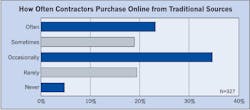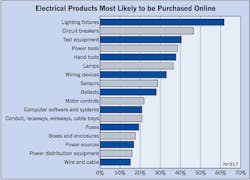Little seems sacred any more in the rapidly changing world of commerce — a lesson electrical contractors and their distributors themselves are learning all too well, sometimes painfully and awkwardly. The rise of e-commerce, the fracturing of entrenched distribution models, and relentless efforts to wring more waste and inefficiency out of the buying and selling function are gently rocking the sturdy foundation of contractor and distributor relationships, revealing pockets of dysfunction and dissatisfaction stirring beneath a surface of apparent calm.
The prospective game changer is the growing array of new, mostly online-enabled channels for sourcing products — notably non-traditional suppliers — in the electrical marketplace. Geared to filling a niche for supplying certain types of products, they’re enticing more electrical contractors with promises of cheaper buys and sometimes faster delivery. Flush with more options — some far from ideal but alternatives, nonetheless — emboldened contractors are doing more than dabbling in new buying channels; unleashed, they’re also critically evaluating relationships with longtime suppliers and recalculating what defines a healthy buyer-seller relationship. In turn, traditional electrical distributors are starting to change how they do business, yielding a mix of responses that can end up either appeasing or alienating customers.
David Gordon, president of Channel Marketing Group, Inc., a Raleigh, N.C.-based business consultant focused on the electrical wholesaling industry, can envision a scenario where non-traditional electrical products distributors continue to chip away at the business of traditional suppliers. But their ultimate impact is likely to be muted, he says, because they’ll be challenged to invest enough in the category to be able to match the product breadth and depth of traditional distributors. Plus, their model will always be geared to more narrow types of buys — ones in which product availability, pricing, quality, and delivery window parameters all match up.
“Areas where contractors are less likely to use some of these online systems include commodities such as pipe and wire, where pricing fluctuates regularly, and in big project scenarios where there’s a defined bill of goods,” he says. “Take those two areas out, and that could amount to 30% or 40% of what contractors are regularly buying.”
Gordon contends that the essential attraction of the new online parts merchants, as well as the supplementary online services that traditional distributors are rolling out, boils down to simply more choice in order placement. These channels can’t guarantee consistently better pricing, but they always offer buyers the chance to research products, compare prices, and place orders virtually at will and with ease, which itself improves the prospect of enhanced efficiency and productivity.
“A lot of the attraction of e-commerce is that it allows for improved productivity via what amounts to an alternative order entry system,” he says.
Two-thirds buy online
Whatever the motivation or value proposition, many electrical contractors are taking advantage of emerging online channels to secure at least some of the supplies they need. That much, and a lot more, has come into sharper focus through the responses of 543 electrical contractors to a recent EC&M survey on purchasing practices.
Conducted in early 2015, and skewed heavily to smaller residential and commercial contractors with between one and four employees, the survey revealed that nearly two-thirds purchase electrical products online. But the survey dug much deeper, revealing through responses to 13 questions and open-ended commentary a contractor community seemingly interested in selectively testing the waters of alternative buying channels and “non-traditional” sources, and, perhaps relatedly, somewhat unsatisfied with the performance of their established electrical products distributors.
While specifically aimed at better understanding how contractors are using online purchasing tools, the survey also sought insight into what contractors were thinking about their suppliers. Prodded to imagine what they’d say to their distributors if they had 20 minutes alone with them in a room, 55 respondents took the time to pen responses, producing an insightful, candid, albeit clearly anecdotal, glimpse into the current state of contractor-supplier relationships (see Candid Survey Comments).
If at all representative, the responses reveal an uneasy buying community eager to let their suppliers know — diplomatically in most cases, less so in others — that the package of services they’re providing could stand some improvement. Many comments reference the emergence of alternative buying channels, and carry a message that might be summed up as “you’re no longer the only game in town.” But the overall tone could be described as “we know you can do better, and we want you to be better because, deep down, we value you.”
Deal hunting. But the survey findings leave little doubt that, smartly structured to offer clear advantages, distributors labeled in the survey as “non-traditional,” in that they’re web-based, could become a potentially disruptive force in the electrical products business.
One clue is the reasons respondents gave for purchasing products online. Of those who do purchase online, “price” emerged as the top driving force, selected by 36% as the single greatest motivating factor (Fig. 1). “Convenience” came in second with 29%, and “selection” was chosen by 26%. Not surprisingly, these are the same factors driving all Internet shopping.
“Let’s not forget, this is the shopper’s era,” commented Bill Wedge, owner of Wedge Electric, Inc., Orange, Calif., in the survey. “There’s very little loyalty extended toward contractors and distributors, and they’re even more subject to price shopping because of the Internet. So pay attention!”
While a rare user so far of non-traditional online-only distributors, Wedge referenced growing price transparency due to the emergence of online parts suppliers. That naturally opens the door to uncomfortable conversations: “It’s troubling for small contractors to find out over time they’ve been getting hammered on pricing in specific areas by someone they thought valued their business,” he says.
When it comes to frequency of purchasing online, it’s a good guess that most contractors are picking their spots, shopping when the circumstances are right. Only 7% of those purchasing online do so “often” through non-traditional sources (Fig. 2), while 28% say they do so “sometimes.” One-third do so “occasionally,” but 24% only do so “rarely,” and 6% never do.
But contractors are using the online services of traditional electrical distributors more frequently. Twenty-three percent purchase online through them “often,” while 19% do so “sometimes.” As with non-traditional sources, one-third do so “occasionally,” while 19% only “rarely” do so, and 5% never do (Fig. 3).
Conventional channel dominates
Online buying is clearly popular, but much of it is taking place within the framework of traditional sources. The typical respondent who does buy online does so through traditional sources three times more frequently than through non-traditional — 67%, and 20%, respectively. Also, regardless of where it’s done, it’s probably safe to say that online buying is nowhere near a regular activity for most contractors.
So what are some of the larger electrical contractors doing on the online buying front? At Continental Electrical Construction Co., Oak Brook, Ill., (No. 45 on EC&M’s 2014 Top 50 Electrical Contractors Listing) online purchasing is so rare as to not be much of a factor, says survey respondent Michael Meyer, a project manager. While he writes that more traditional suppliers should consider integrating “Amazon/Grainger-like capabilities” into their ERP systems to allow for improved access to detailed product information, he says online purchasing doesn’t seem to present a lot of tangible benefits for the company. Some traditional suppliers offer it, but its value is limited, while non-traditional suppliers’ delivery logistics probably wouldn’t be a good fit, he says.
“On projects where you’re buying the same things over and over, pulling off of old orders and refilling, their sites work well, but if you’re trying to research and purchase other things, you can find yourself in a black hole,” he says.
Contractors who do purchase online from non-traditional sources appear to be directing most of their business to the leading sites. Given six choices for purchasing electrical products, more respondents selected the website of home improvements retailer Home Depot than any other — but by a very slim margin (Fig. 4). Fifty-four percent checked homedepot.com as a preferred website, while both Grainger and Amazon were each selected by 52%. Much farther behind were another home improvement retailer’s site (Lowe’s) with 28%, 1000bulbs.com with 20%, and Fastenal with 11%.
One of the factors clearly drawing contractors to the online marketplaces of alternative suppliers is a perception of eroding service. While price is a factor, as the survey demonstrated, the simple availability of another option is causing contractors who’ve long counted on supplier support to look elsewhere — at least as a show of protest.
Survey participant Peter Argyropoulos, owner of Petros Electric, Lancaster, Pa., has grown frustrated with one key supplier’s more corporate-driven just-in-time delivery model. It may help them manage inventory better, but it takes a toll on his ability to count on common products being in stock, he says.
“It’s problematic going into a supply house and not being able to find basic items, very frustrating,” he says. “You start to wonder if you should just go to The Home Depot.”
Price, though, isn’t the top concern. His advice to traditional suppliers is to focus on quality and service: “Don’t try to compete with the box store.” he says. “If we’re still coming to you, it’s because we think we get a better product, even if the price is slightly higher.”
Focused online buying
Contractors who are buying online are checking out an array of products, according to the survey. But the biggest movers seem to
be concentrated in the comparatively “low-tech” area. From a list of 26 broad product categories, respondents were asked to identify any and all they were most likely to purchase online (see Fig. 5).
The leading response? Far and away, light fixtures. That category was named by 62% of respondents, hardly a surprise given the growth and maturation of the LED lighting market and the heated competition among global manufacturers and distributors. Rounding out the top five product categories were circuit breakers, with a 47% tally; test equipment (40%); power tools (39%); and hand tools (38%). The next five most-often mentioned categories were lamps, wiring devices, sensors, ballasts, and boxes/enclosures.
Citing delivery time as the main reason, Argyropolous has begun using Amazon Supply more, especially for lighting products. A lack of selection and assistance from local suppliers drove him to start researching online sellers’ products.
“These are people who probably take lighting catalogs to the bathroom to read, but they spend 10 minutes trying to get you an answer, and they shrug their shoulders,” he says. “If I have to take over this research, I figure I’m also going to try to find a better price while I’m at it. At that point, finding something cheaper is a breeze.”
A better price or any other tangible benefit conferred by an online channel can be quickly hollowed out if it ends up faulty or wrong for the job. That’s where online commerce can face its real test: the buyer’s ability to secure a refund or navigate a return.
But the survey found that returns haven’t been an issue for a majority of online purchasers. Of those purchasing online, 66% said they’ve never had to return a product to an online merchant. And of the 33% who have had to return, 38% rated the process “very easy” or “easy.” While 15% termed it “difficult” or “very difficult,” 46% were “neutral” on the issue.
Wedge, the contractor, cites returns and warranties as one of the top reasons he hasn’t bought much online through non-traditional distributors.
“I think it may be harder to get “make-goods” on Net-bought products,” he says. “That’s where I think traditional wholesalers may have a leg up. My feeling is that anything I need to purchase online I better know damn well it’s what I want and not to expect to have to return it.”
But in the end, worst-case scenarios like that may ultimately take a back seat to more pressing matters contractors face on a daily basis, such as being able to quickly lay hands on competitively priced materials that meet specifications.
That’s the essential proposition online merchants working to establish a foothold in the electrical products industry are offering and situated to deliver. It’s one that’s not only winning them a chunk of the business but also impacting how more contractors buy products and evaluate their distributors — and how those traditional distributors themselves come to market.
For better or worse, says Jim Totzke, executive vice president of operations for Faith Technologies, Inc., a Menasha, Wisc., electrical contractor (No. 12 on EC&M’s 2014 Top 50 Electrical Contractors Listing), purchasing practices in the industry are indeed changing. Deftly using their unique, but narrow advantages, he says, online sellers are helping to change the terms of the discussion between contractors and distributors, and, for the foreseeable future, there’s probably room for both.
The winning players or formula for success may not emerge for some time, but from the contractor side Totzke is beginning to see something new take shape.
“From our perspective, what we’re trying to do is leverage our suppliers to provide us with more value,” he says. “Whether it’s Amazon, Graybar, or whomever, we’re looking for suppliers who can help us save money — not just from a product price perspective, but in terms of where and how it’s delivered, how it’s packaged, and when it’s delivered. Their ability to define themselves through the additional value they offer is where they’ll make their money.”
Zind is a freelance writer in Lee’s Summit, Mo. He can be reached at [email protected].
Sidebar 1: Candid Survey Comments
When asked what they’d say to their electrical distributors if they had them in a room for 20 minutes alone, here’s what some survey respondents had to say. Although some expressed complete satisfaction and offered up no ideas for improvement, others had distinct words of advice.
• Lower your prices to compete with online.
• Customer relations, speed, and efficiency of delivering products is key! Time and time again, I turn to online due to people not caring to put the effort in. When I have to find the new products, I will probably not purchase them through you.
• Stop being so 19th century with old-school techniques and customer approaches. Your good-old-boy electrician is a thing of the past.
• Educate your people on products. Too often I’m dealing with a salesman who has no idea what I’m doing in the field.
• Training the warehouse workers is essential to continued purchases from your company. There is nothing more frustrating than being told you have a product in stock and ordering it — only to have the wrong material delivered to the job site and holding up the project.
• Have a better website that shows info and/or videos of new products and how they save time and money. Have an easy-to-use browser of inventory, and keep prices as low as possible.
• Remember contractors are customers. Treat them as though you were running a retail business. Make them feel welcome, and show your appreciation for their business. And more importantly, price all your contractors fairly. One contractor with two employees should not have to pay say 30% more for an item than a contractor with 20 employees. Yes, he might buy more, but they are probably competing on the same jobs!
• Match online prices, deals, and rebates from other companies to encourage business owners to use one sole source for materials. Need more competitive pricing. We want to give business to the local guy or the small distributor rather than a big box store/website, but we cannot currently do that as online prices often beat out the distributor. If not for next-day delivery that allows us to meet short deadlines, we would probably purchase even more stuff online because of the pricing.
• Do what you promised.
• They could do a better job with fill rates. There seems to be too many back orders. I understand every branch cannot have every item, but maybe they could all have the “fast movers,” and then each branch focus on one area a little heavier in each region. It seems like companies such as Amazon can ship things across the country in a day or two, and, in many cases, speed is way more important than price.
• Offer more training opportunities, even if it’s just to notify us of manufacturer online training. Have trained counter staff (knows a chase nipple from a conduit hub) or how to access more product online.
• Move away from “just-in-time” distribution. It’s not working well. Get the lighting manufacturers to do in-depth workshops at supply houses. Have them do demos. Don’t make us depend on catalogs and online hearsay to make lighting decisions. Don’t try to compete with box stores. If we’re still coming to you, it’s because we think we get a better product from you, even if the price is slightly higher.
• Keep an adequate stock of items. It is frustrating when I stop in to pick up an item that is rather common (the local big box store has 10 of them on the shelf), and my distributor has to order it in from another branch.
• Be open much longer hours so we don’t have to keep going to Lowe’s and The Home Depot.
• Provide an interactive website where orders can be placed for common items, and each order can be generated with a unique PO number and delivery address.
• Most of the electrical distributors are locked into a very limited narrow band of products. If a question arises about the product, most of the time their sales people are not trained in the product to give you a detailed answer. Because of today’s economy, most of the distributors do not and will not stock other than a limited amount of inventory, or there is an ordering wait. This is not what I am wanting because sometimes this item may be vital for the repair of the customer’s system.
• Make their website more interactive.
• They should give us on-line access to their current stock, as well as current pricing at our level, so we could prepare bids after hours — when the supplier is normally closed.
Sidebar 2: Taking on the Upstarts
Who faces the bigger challenge? An online merchant looking to become a trusted product specialist or that specialist needing to become better at logistics? That’s an oversimplified, but essentially accurate portrayal of the faceoff between electrical distributors and non-traditional suppliers like Amazon Supply.
Electrical distributors may arguably have the better hand. Today, the IT tools for improving logistics are more readily available than the institutional knowledge needed to become a specialist.
A 2014 National Association of Electrical Distributors-sponsored study of the challenge posed by alternate distribution channels emphasizes the tech aspects. Among its recommendations: hire top-notch IT people; develop an online strategy; upgrade Web capabilities; battle online competitor price advantages with smarter volume discount strategies; and lobby manufacturers to impose minimum prices for online sales.
That’s sound advice, but it’s just one of the cards electrical distributors can play, say executives with two leading distributors. Bill Mansfield, senior vice president of sales and marketing with St. Louis-based Graybar, says the company has been improving both its digital platforms and the people aspect of its business. Last year, the company launched an enhanced Online Store and a SmartStock mobile app to improve online ordering. It’s also been refining its use of teams to advise customers on energy and supply chain efficiencies.
“We’re finding that most customers still want a combination of online accessibility and personal contact, and we’re working to find that balance,” he says.
Bob Settle, vice president, marketing, with Crescent Electric Supply Co., East Dubuque, Ill., says the emergence of non-traditional competitors is simply reinforcing the company’s commitment to all aspects of service.
Crescent, he says, rolled out a DOS-enabled online ordering system in the early 1990s. The newest generation was launched in 2013; now, 200,000 SKUs are available. What’s driving Crescent just as hard now is the people side of the equation.
“A customer survey told us that people are our biggest asset,” he says. “ECs want access to knowledgeable people at all touch points of the purchase, inside sales and quotation managers, counter sales and warehouse personnel, outside sales managers, and credit managers.”
Settle likes the position distributors are in facing online sellers, but he doesn’t downplay the importance of being able to beat the Amazons of the world at their own game.
“Amazon is a formidable company with the ability to be a disruptive force,” he says. “The extent to which they will be successful is (somewhat) dependent on how distributors respond to changes in buying habits and preferences of their customers and their ability to provide robust, feature-rich online marketplaces to compete with online-only companies.”
About the Author
Tom Zind
Freelance Writer
Zind is a freelance writer based in Lee’s Summit, Mo. He can be reached at [email protected].






